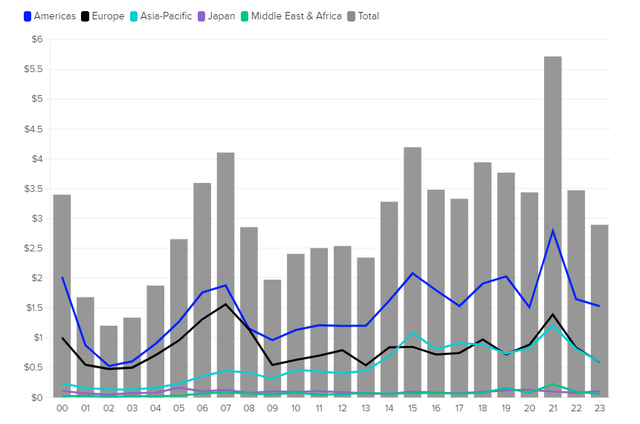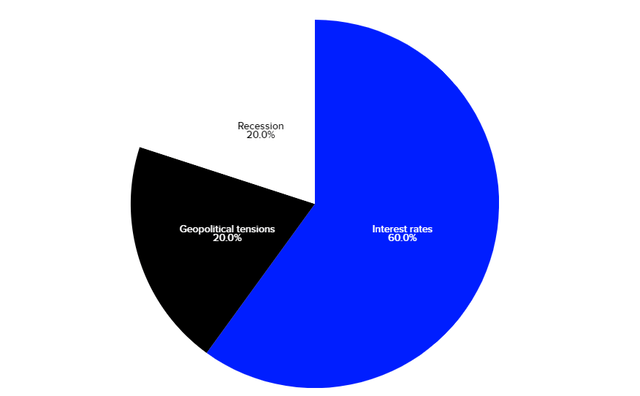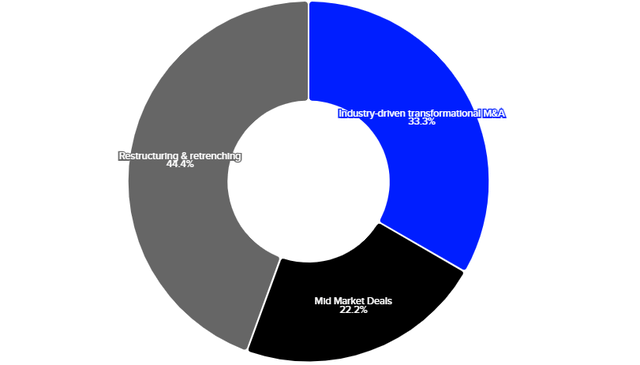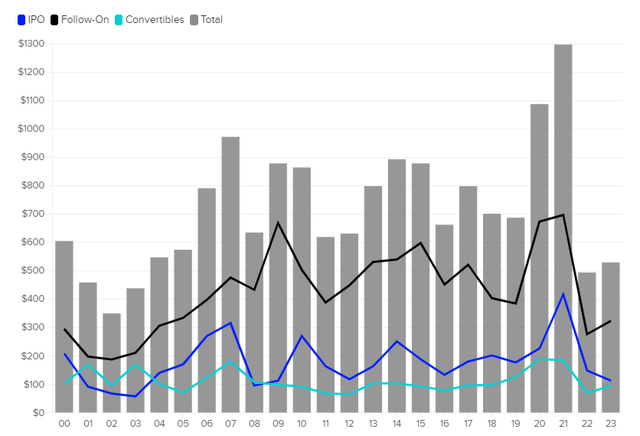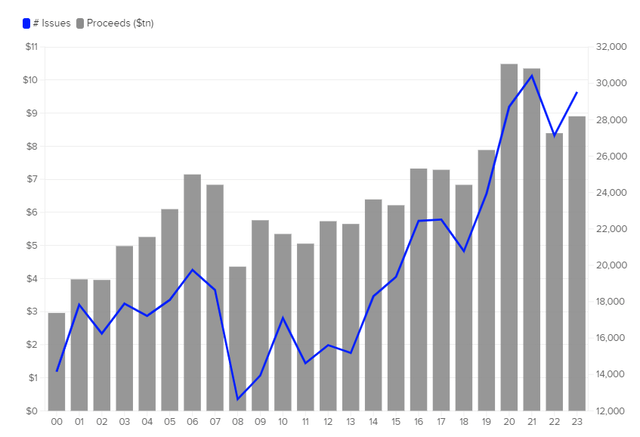Andrew Brookes/Image Source via Getty Images
By Lucille Jones, Senior Manager, Deals Intelligence and Matt Toole, Director Deals Intelligence – I&A
The sense of anticipation in capital markets at the start of 2024 has rarely been higher. LSEG’s Deals Intelligence experts, Matthew Toole and Lucille Jones, took a closer look at the trends in M&A and equity/debt issuance, in a hotly-anticipated online session. Their take: while many of the aggregated results for 2023 look dismal, a closer (quarterly, regional and product-based) view reveals a surprising level of positivity for the year ahead.
The combined value of global M&A transactions failed to reach $3trn in 2023 – depths not seen for a decade. While the trend in the latter part of 2022 was downward, this further deterioration was a “plot twist” few were expecting, particularly following the heady Covid years when deal values were twice this level.
A 17% year-on-year decline in M&A to $2.9trn during 2023 marked a second consecutive annual double-digit fall and represents the severest contraction since the global financial crisis. Every major segment of the corporate world was affected, with cross-border, domestic, mega, private equity and emerging market all seeing declines.
However, a quarterly view tells a more promising story: there was an overall tone change in the last part of 2023, with an improving tone in the market and an end of year rush to announce deals that fed into a markedly stronger Q4 for world-wide announced M&A, up 20% from Q3, and the strongest three-month period for 18 months. It is also notable that there was a clear pick-up in mega deals, with 11 announced in the quarter part of the year.
In addition, there were more than 55,000 deals completed in 2023, which is down on the previous two years, but more than all other full year deal counts since our records began in 1980.
And consider the confluence of macro-economic challenges: steeply rising interest rates, broader concerns around the economy, stricter anti-trust rules, geo-political tensions, bank failures and conflict. Is it so surprising that this tsunami of external factors put the brakes on the complex and delicate activity of corporate acquisitions?
GLOBAL MERGERS & ACQUISITIONS BY REGION ($TN)
Looking closer at M&A
Regionally, the Americas were down just 7%, where the US led the way in M&A, with a decline of just 5% on 2022. Most of the year’s landmark deals involved a US company.
This is in stark contrast to most other regions, with Europe down 28% (including an eye-catching 43% fall in UK M&A), while Asia-Pacific fell 26%. But these full-year figures are ameliorated by an improving picture towards the year-end, as well as some significant deal activity that is coming through into January 2024.
WHICH FACTOR WILL HAVE THE MOST SIGNIFICANT EFFECT ON OVERALL CORPORATE FINANCE ACTIVITY INTO 2024?
Energy & Power was 2023’s top sector, constituting 17% of all deal activity globally. The value of deals in the sector rose 12% to a round $500.0bn, boosted by two very large acquisitions by US oil majors towards the end of the year. With rising oil prices as a consequence of geo-political unrest, we could see more free cash available for consolidation activity in this sector in the year ahead.
Healthcare has been another bright spot, and one of the few sectors that grew, by 8%, in M&A activity in 2023, as most of the big pharma names put their Covid era cash piles to work.
Technology M&A saw a heavy 47% decline to $368bn, although we should remember that we are comparing to a year that saw two of the largest tech deals of all time: Microsoft’s (MSFT) acquisition of Activision Blizzard and Broadcom (AVGO) VMware (VMW), both valued at more than $60bn.
Private equity activity fell 29% year-on-year, but still accounts for an historically high one-fifth of all M&A. While financial sponsors are active across sectors, interest in technology, and software in particular, stood out, constituting the lion’s share of PE deals by number. As interest rates begin to stabilise, we may see more activity from financial sponsors.
Which activity will dominate M&A in 2024?
Slow IPOs, promising follow-ons
IPO markets declined a further 24% in 2023 to $113bn, the lowest level for 14 years. Many flotations were pulled or postponed during the year. Flotation proceeds on US exchanges doubled during the year, albeit from a low base.
More encouraging was the market for follow-on equity financings, which grew by 17% to $323bn during 2023, indicating continued appetite for quality names. Meanwhile, convertible issuance was up 34% to $93bn, a level that could be surpassed in 2024 as companies need to refinance maturing debt.
GLOBAL EQUITY CAPITAL MARKETS ($BN)
The rise and rise of DCM
While the astonishing levels of debt capital market activity witnessed since the pandemic have come off slightly, they remain at an historically elevated level, with $8.9trn debt capital raised across all products, and a 6% increase on 2022.
Global investment-grade corporate bonds were up 5% to $4.3trn for 2023 overall (although with a notable downward trend towards year-end), while high-yield saw a major resurgence, with a 66% growth in issuance to $219bn.
Meanwhile, international bonds were up 7%, despite some weakening in Asia, including in China, hampered by depressed M&A markets.
In addition, global syndicated loans were down 15% in 2023 to just $4.3trn – a market significantly dependent on the health of M&A markets.
Even so, DCM remains a tremendously dynamic market, with plenty of innovation and a plurality of funding activity across the world. As rates stabilise, we could expect continued growth across these markets, and indeed our team already report a very strong January, with the number of issuers coming to market in the early new year.
GLOBAL DEBT CAPITAL MARKETS ($TN)
A case-in-point are green and social bonds – the latter coming-of-age during the pandemic era. In 2023, green bonds grew 10% in 2023 to reach $422bn. A general focus on sustainability has become very mainstream for issuers in the DCM area and represents about 10% of the market across all categories.
Responding to questions around green-washing, our speakers noted a marked shift to a growing linked market, where the cost of finance is linked to sustainability KPIs. So far, we have not seen a decline in returning issuers. However, there is a lot of maturing debt this year, so it will be revealing to monitor who comes back to market.
Fees suffer from wider volatility
It is no surprise to see global investment banking fees took a 7% hit in 2023, to total $106bn, the slowest year since 2018, with income dented by subdued M&A, where income fell by a quarter.
The Americas contributed 47% to the global total, taking home $49.6bn, while EMEA bankers saw a 6% fall to $25bn and a similar decline in Asia-Pacific took income to $27bn. Bucking the trend, Japanese dealmakers enjoyed a 24% increase compared to 2022.
The total share of wallet by the top 10 banks totaled 36%, a fall of 1.25 percentage points in 2022. While a handful of global US banks continued to dominate the global capital markets across most categories, there are interesting strategic plays being initiated by several European and Japanese banks that could make for interesting competition in the years ahead.
LEGAL DISCLAIMER
Republication or redistribution of LSE Group content is prohibited without our prior written consent.
The content of this publication is for informational purposes only and has no legal effect, does not form part of any contract, does not, and does not seek to constitute advice of any nature and no reliance should be placed upon statements contained herein. Whilst reasonable efforts have been taken to ensure that the contents of this publication are accurate and reliable, LSE Group does not guarantee that this document is free from errors or omissions; therefore, you may not rely upon the content of this document under any circumstances and you should seek your own independent legal, investment, tax and other advice. Neither We nor our affiliates shall be liable for any errors, inaccuracies or delays in the publication or any other content, or for any actions taken by you in reliance thereon.
Copyright © 2024 London Stock Exchange Group. All rights reserved.
The content of this publication is provided by London Stock Exchange Group plc, its applicable group undertakings and/or its affiliates or licensors (the “LSE Group” or “We”) exclusively.
Neither We nor our affiliates guarantee the accuracy of or endorse the views or opinions given by any third party content provider, advertiser, sponsor or other user. We may link to, reference, or promote websites, applications and/or services from third parties. You agree that We are not responsible for, and do not control such non-LSE Group websites, applications or services.
The content of this publication is for informational purposes only. All information and data contained in this publication is obtained by LSE Group from sources believed by it to be accurate and reliable. Because of the possibility of human and mechanical error as well as other factors, however, such information and data are provided “as is” without warranty of any kind. You understand and agree that this publication does not, and does not seek to, constitute advice of any nature. You may not rely upon the content of this document under any circumstances and should seek your own independent legal, tax or investment advice or opinion regarding the suitability, value or profitability of any particular security, portfolio or investment strategy. Neither We nor our affiliates shall be liable for any errors, inaccuracies or delays in the publication or any other content, or for any actions taken by you in reliance thereon. You expressly agree that your use of the publication and its content is at your sole risk.
To the fullest extent permitted by applicable law, LSE Group, expressly disclaims any representation or warranties, express or implied, including, without limitation, any representations or warranties of performance, merchantability, fitness for a particular purpose, accuracy, completeness, reliability and non-infringement. LSE Group, its subsidiaries, its affiliates and their respective shareholders, directors, officers employees, agents, advertisers, content providers and licensors (collectively referred to as the “LSE Group Parties”) disclaim all responsibility for any loss, liability or damage of any kind resulting from or related to access, use or the unavailability of the publication (or any part of it); and none of the LSE Group Parties will be liable (jointly or severally) to you for any direct, indirect, consequential, special, incidental, punitive or exemplary damages, howsoever arising, even if any member of the LSE Group Parties are advised in advance of the possibility of such damages or could have foreseen any such damages arising or resulting from the use of, or inability to use, the information contained in the publication. For the avoidance of doubt, the LSE Group Parties shall have no liability for any losses, claims, demands, actions, proceedings, damages, costs or expenses arising out of, or in any way connected with, the information contained in this document.
LSE Group is the owner of various intellectual property rights (“IPR”), including but not limited to, numerous trademarks that are used to identify, advertise, and promote LSE Group products, services and activities. Nothing contained herein should be construed as granting any licence or right to use any of the trademarks or any other LSE Group IPR for any purpose whatsoever without the written permission or applicable licence terms.
